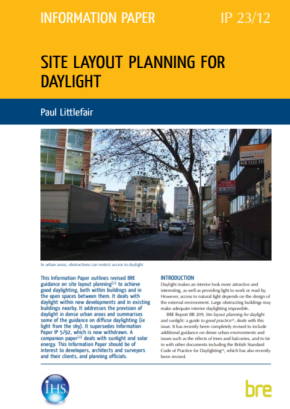Site layout planning for daylight IP 23 12
Site layout planning for daylight (IP 23/12) was written by Paul Littlefair and published by BRE on 16 October 2012. It superseded IP5/92 which was withdrawn.
Daylight makes an interior look more attractive and interesting, as well as providing light to work or read by. However, access to natural light depends on the design of the external environment. Large obstructing buildings may make adequate interior daylighting impossible
This 6-page Information Paper outlines revised BRE guidance on site layout planning to achieve good daylighting, both within buildings and in the open spaces between them. It deals with daylight within new developments and in existing buildings nearby. It addresses the provision of daylight in dense urban areas and summarises some of the guidance on diffuse daylighting (ie light from the sky rather than direct from the sun).
This Information Paper should be of interest to developers, architects, surveyors, clients, and planning officials.
Its contents are:
- Introduction.
- Daylight within a new development.
- Existing buildings.
- Trees and hedges.
- Conclusions.
- References.
It is available at: https://www.brebookshop.com/details.jsp?id=327076
See also: Site layout planning for daylight and sunlight.
[edit] Related articles on Designing Buildings Wiki
- 7 ways better lighting can improve your health.
- BRE articles on Designing Buildings Wiki.
- BRE Expert Collection 6 Daylight and shading.
- Building Research Establishment.
- EN 17037 Daylight in buildings.
- Health and wellbeing impacts of natural and artificial lighting.
- Light obstruction notice.
- Light pollution.
- Lighting and energy efficiency.
- Lighting and health infographic.
- Lighting of construction sites.
- Natural light.
- Passive building design.
- Right to light.
- Site layout planning for daylight and sunlight.
- Solar gain in buildings.
- Use of lighting to improve health and wellbeing.
Featured articles and news
Gregor Harvie argues that AI is state-sanctioned theft of IP.
Many resources for visitors aswell as new features for members.
Using technology to empower communities
The Community data platform; capturing the DNA of a place and fostering participation, for better design.
Heat pump and wind turbine sound calculations for PDRs
MCS publish updated sound calculation standards for permitted development installations.
Homes England creates largest housing-led site in the North
Successful, 34 hectare land acquisition with the residential allocation now completed.
Scottish apprenticeship training proposals
General support although better accountability and transparency is sought.
The history of building regulations
A story of belated action in response to crisis.
Moisture, fire safety and emerging trends in living walls
How wet is your wall?
Current policy explained and newly published consultation by the UK and Welsh Governments.
British architecture 1919–39. Book review.
Conservation of listed prefabs in Moseley.
Energy industry calls for urgent reform.
Heritage staff wellbeing at work survey.
A five minute introduction.
50th Golden anniversary ECA Edmundson apprentice award
Showcasing the very best electrotechnical and engineering services for half a century.
Welsh government consults on HRBs and reg changes
Seeking feedback on a new regulatory regime and a broad range of issues.
CIOB Client Guide (2nd edition) March 2025
Free download covering statutory dutyholder roles under the Building Safety Act and much more.

























